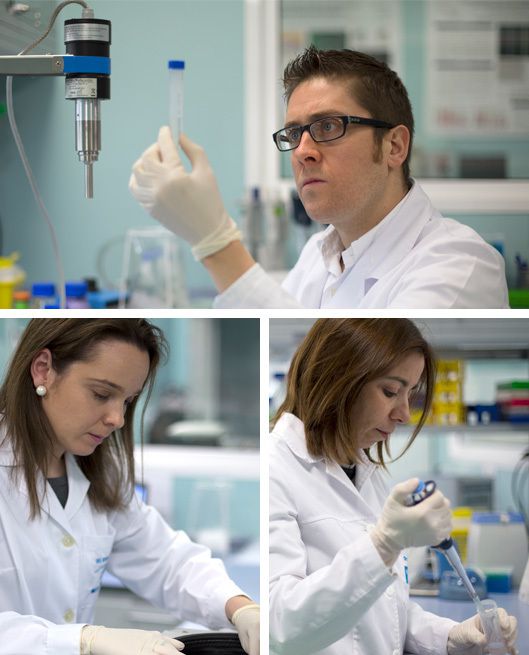OCULAR GENETICS UNIT (OR UNIT OF NEURODEGENERATIVE DISEASES)
This Unit is headed by Dr. Héctor González Iglesias and includes Dr. Lydia Álvarez, Montserrat García and the Pre-Doctoral Researcher Sara Rodríguez Menéndez.
In general terms, this Research Unit focuses its activity on the study of the most prevalent and devastating age-associated eye complaints, glaucoma and Age-related Macular Degeneration (AMD), in order to promote healthy ageing and to improve the patient´s quality of life. Firstly, we wish to continue the ambitious line of research dedicated to the “Early Diagnosis of Glaucoma”, enabling a diagnosis of the most prevalent glaucomatous complaints before damage is irreversible and making preventive treatment possible. In addition, this study may lead to the discovery of new therapeutic targets and ultimately the development of neuroprotective agents. Secondly, we want to boost and boost the line of research in DMAE, for which we will evaluate the antioxidant system zinc-metallothioneins as a new therapeutic target. Finally, we will continue genetic studies associated with eye diseases.

1. DISCOVERY AND VALIDATION OF GLAUCOMA BIOMARKERS
Differential proteomic techniques have identified serum proteins that are candidates for biomarkers with a high degree of specificity for two forms of glaucoma: Primary open-angle glaucoma and pseudo exfoliative glaucoma. We are currently applying innovative analytical technologies, in partnership with the Stable Enriched Isotopes Group of the University of Oviedo, which allow the simultaneous quantification of several proteins in large population groups.
Our objective is to identify and validate biomarkers that can be used for an early diagnosis of glaucoma. Simultaneously, we are using an animal model of glaucoma, the DBA / 2J mouse, which develops glaucoma spontaneously throughout its life, in 70% of the cases, to determine if there are alterations in the levels of the serum proteins candidates for biomarkers in the transition between the pre-glaucomatous and glaucomatous stages. The aim of this line is to devise strategies to block this transition and thus curb the development of this complaint.
2. PSEUDO EXFOLIATIVE GLAUCOMA GENETICS
Pseudo exfoliative Glaucoma (GPEX) is the most common form of open angle secondary glaucoma and develops in the context of Pseudo Exfoliative Syndrome (SE).
There is a strong association between SE / GPEX and several single nucleotide polymorphisms (SNPs) in the lysyl oxidase-like gene 1 (LOXL1), including SNPs, rs2165241, rs1048661 and rs3825942. Therefore, we seek to undertake the study of the most well-known variants and to identify the rare genetic variants in the LOXL1 gene, and to study its association with GPEX in the Spanish population.
3. AGE-RELATED MACULAR DEGENERATION GENETICS
AMD is the leading cause of blindness among the elderly population in industrialized countries. Age, smoking, obesity, dietary fat intake and the presence of rare SNPs may contribute to the development of the disease.
At present, we are studying the association of the genetic variants of some genes involved in the activation of the complement system, specifically the complement factors CFH, CFI, CFB and complement components C2 and C3, with the pathophysiology of the cases with intermediate and advanced levels of AMD.
4. METALOMETRY IN HUMAN EYE DISEASES
A focus on the Zinc-Metallothionein system. Metallothioneins (MTs), a group of low molecular mass proteins with high affinity for metal ions, are abundant in the human eye. These proteins are involved in neuroprotection, cellular zinc homeostasis, and in defence against inflammation and oxidative stress.
These properties are probably mediated by the ability of MTs to bind and donate zinc ions in a redox-dependent form. Based on the observation that ocular cells respond strongly to excess extracellular zinc, vigorously increasing the expression (mRNA and protein) of intracellular MTs and inhibiting the expression of pro-inflammatory cytokines, we have proposed that the Zinc-MT redox cycle (Zn-MT) can suffer an imbalance due to the oxidative stress to which some eye tissues are subjected in some eye diseases. We are working on an experimental model to regenerate MTs under reduced conditions, restore the antioxidant status of these proteins and block the inflammatory process associated with AMD.


